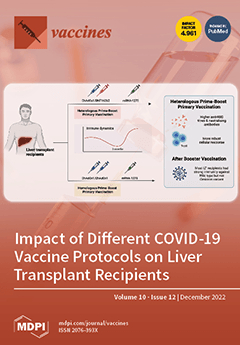Low pathogenic avian influenza (LPAI) H9N2 virus is one of the major poultry pathogens associated with severe economic losses in the poultry industry (broiler, layers, breeders, and grandparents’ flocks), especially in endemic regions including the Middle East, North Africa, and Asian countries. This
[...] Read more.
Low pathogenic avian influenza (LPAI) H9N2 virus is one of the major poultry pathogens associated with severe economic losses in the poultry industry (broiler, layers, breeders, and grandparents’ flocks), especially in endemic regions including the Middle East, North Africa, and Asian countries. This work is an attempt to evaluate the efficacy of whole inactivated H9N2 vaccine (MEFLUVAC
TM H9) in turkey poults kept under laboratory and commercial farm conditions. Here, 10,000 white turkey poults (1-day old) free from maternally derived immunity against H9N2 virus were divided into four groups; G1 involved 10 vaccinated birds kept under biosafety level-3 (BLS-3) as a laboratory vaccinated and challenged group, while G2 had 9970 vaccinated turkeys raised on a commercial farm. Ten of those birds were moved to BLS-3 for daily cloacal and tracheal swabbing to check for the absence of any life-threating disease, before conducting analyses. G3 (10 birds) served as a non-vaccinated challenged control under BSL-3 conditions, while G4 (10 birds) was used as a non-vaccinated and non-challenged control under BSL-3 conditions. Sera were collected on days 7-, 14-, 21-, and 28-post-vaccinations to monitor the humoral immune response using a hemagglutination-inhibition (HI) test. At these same intervals, cloacal and tracheal swabs were also checked for any viral infection. The challenge was conducted 28 days post-vaccination (PV) using AI-H9N2 in BSL-3 by intranasal inoculation of 6-log10 embryo infective dose
50 (EID
50). At 3-, 6-, and 10-days post-challenge, oropharyngeal swabs were taken from challenged birds to quantify viral shedding by quantitative polymerase chain reaction (qRT-PCR). The results of this study showed that vaccinated groups (G1/2) developed HI titers of 1.38, 4.38, 5.88, and 7.25 log
2 in G1 vs. 1.2, 3.8, 4.9 and 6.2 log
2 in G2 when measured at 7-, 14-, 21- and 28-days PV, respectively, while undetectable levels were recorded in non-vaccinated groups (G3/4). Birds in G3 showed 90% clinical sickness vs. 10% and 20% in G1/2, respectively, over a 10-day monitoring period following challenge. Vaccinated birds showed a significant reduction in virus shedding in terms of the number of shedders, amount of shed virus and shedding interval over the non-vaccinated challenged birds. Regarding mortality, all groups did not show any mortality, which confirms that the circulating H9N2 virus still has low pathogenicity and cannot cause mortality. However, the virus may cause up to 90% clinical sickness in non-vaccinated birds vs. 10% and 20% in laboratory- and farm-vaccinated birds, respectively, highlighting the role of the vaccine in limiting clinical sickness cases. In conclusion, under the current trial circumstances, MEFLUVAC
TM-H9 provided protective seroconversion titers, significant clinical sickness protection and significant reduction in virus shedding either in laboratory- or farm-vaccinated groups after a single vaccine dose.
Full article






